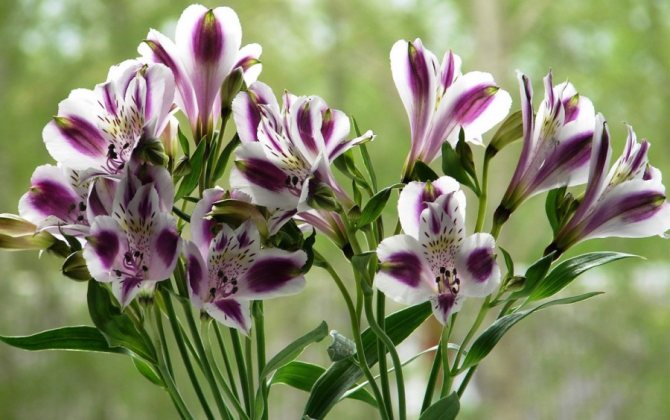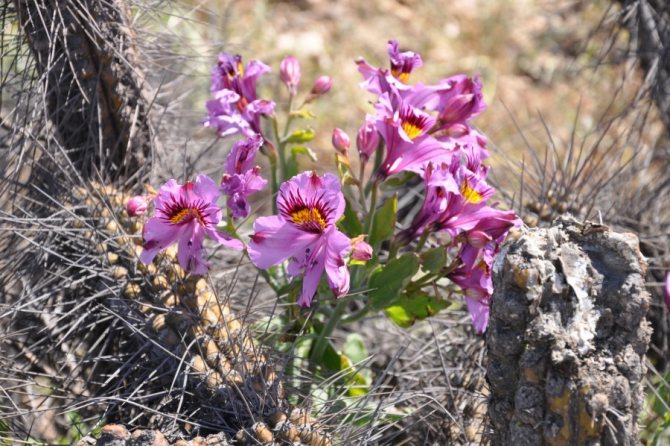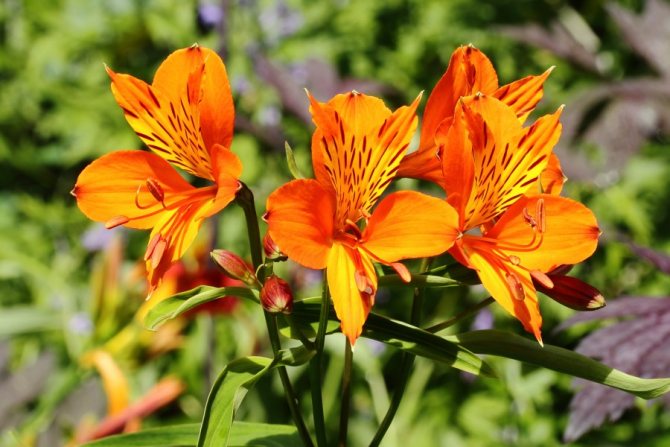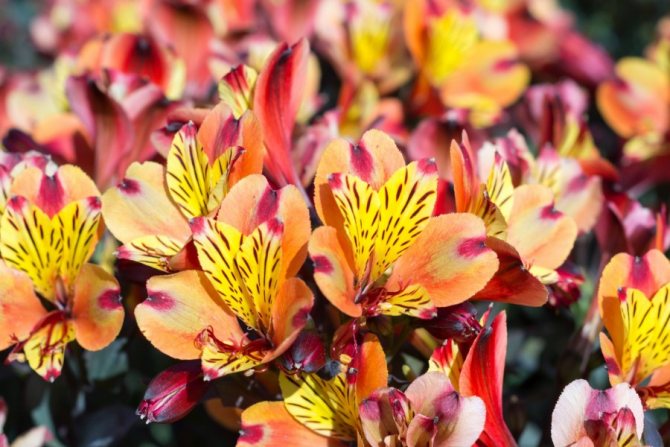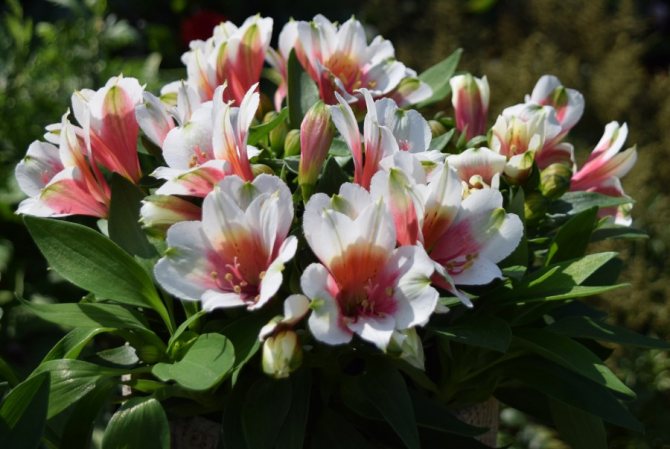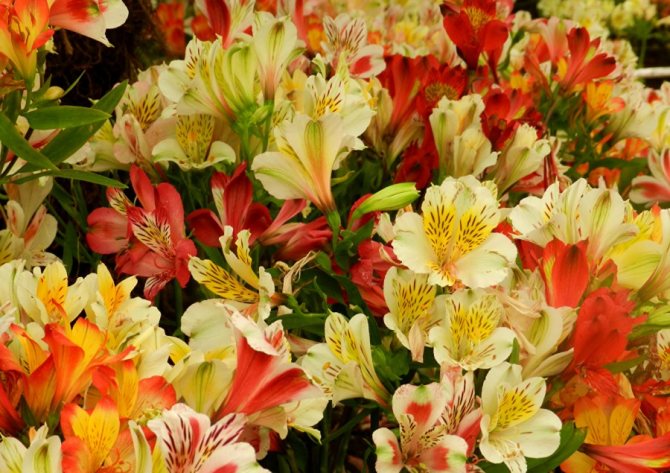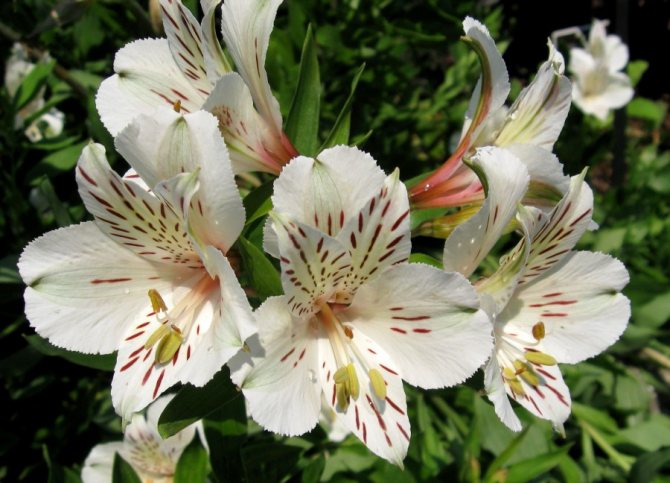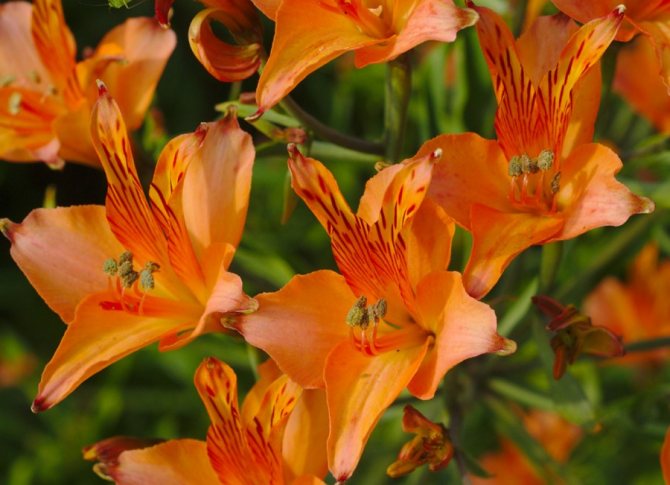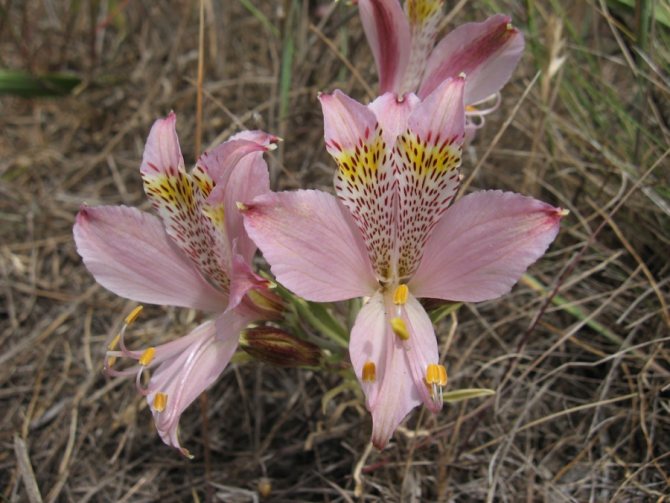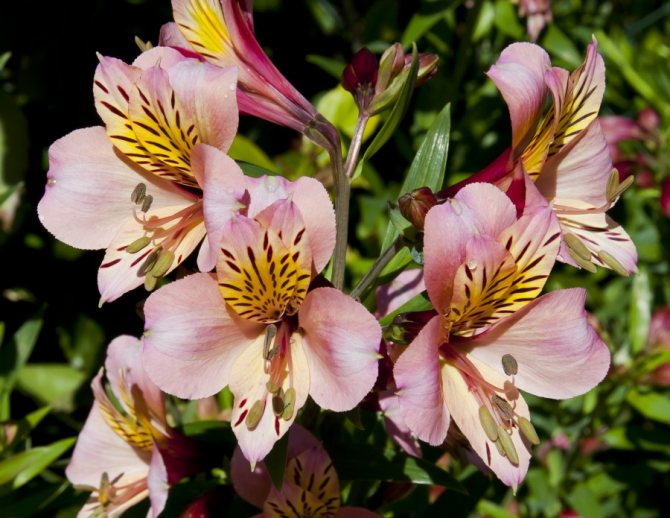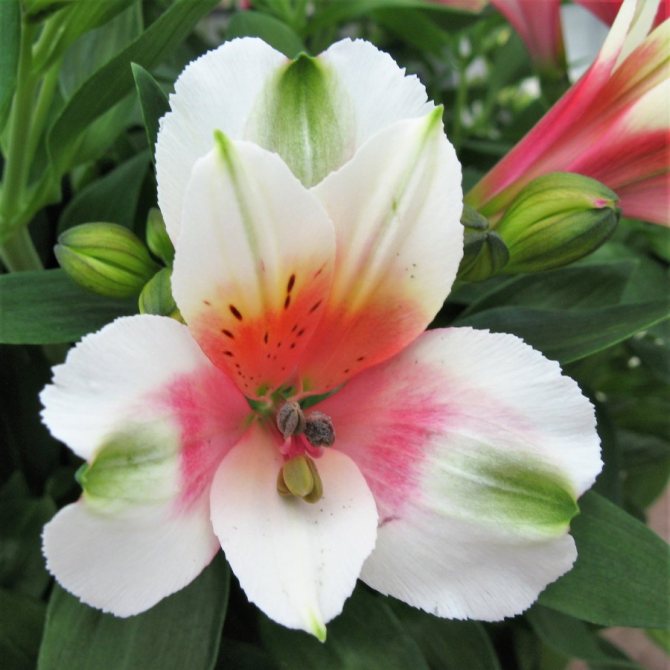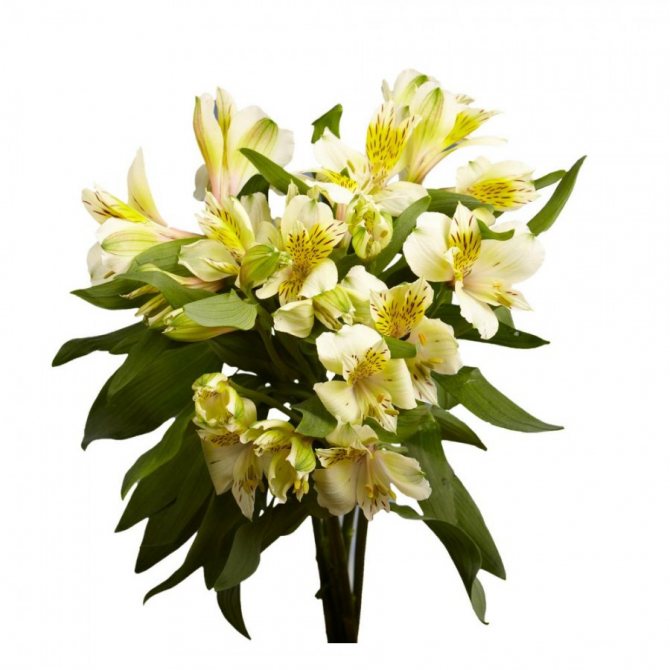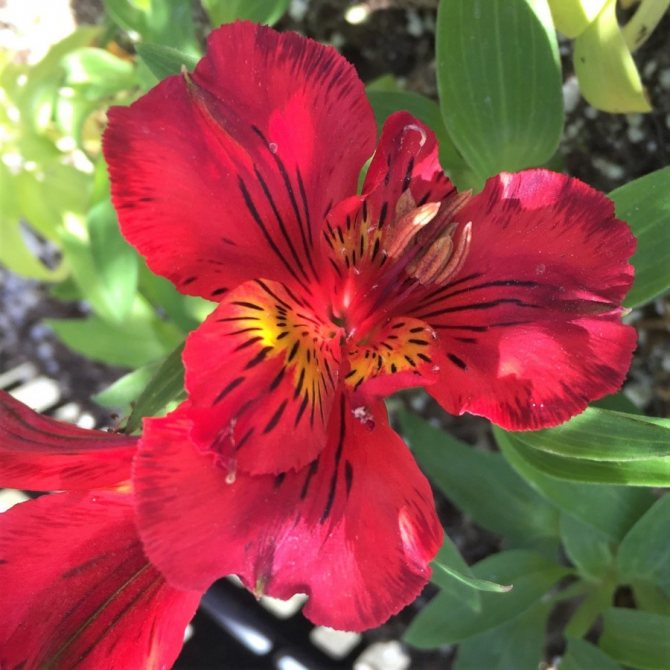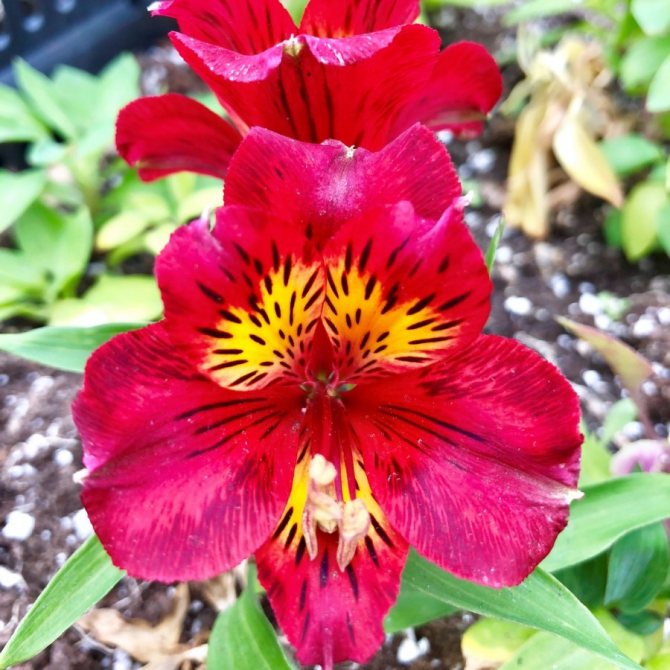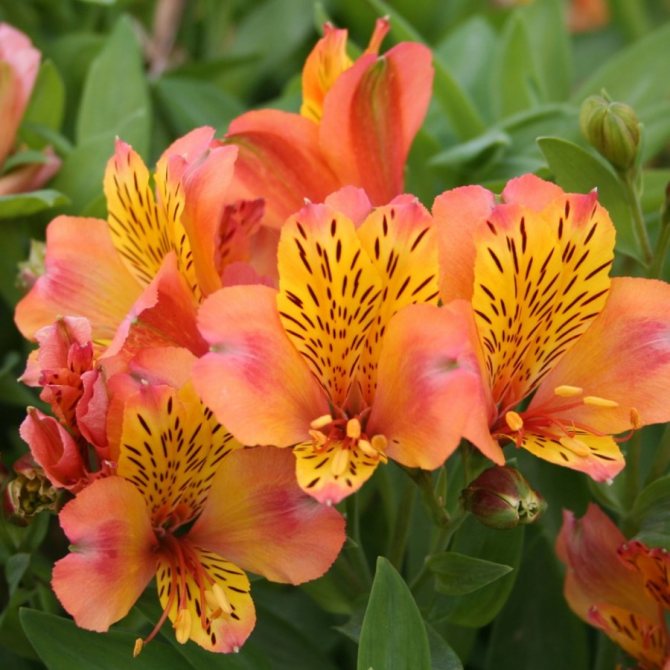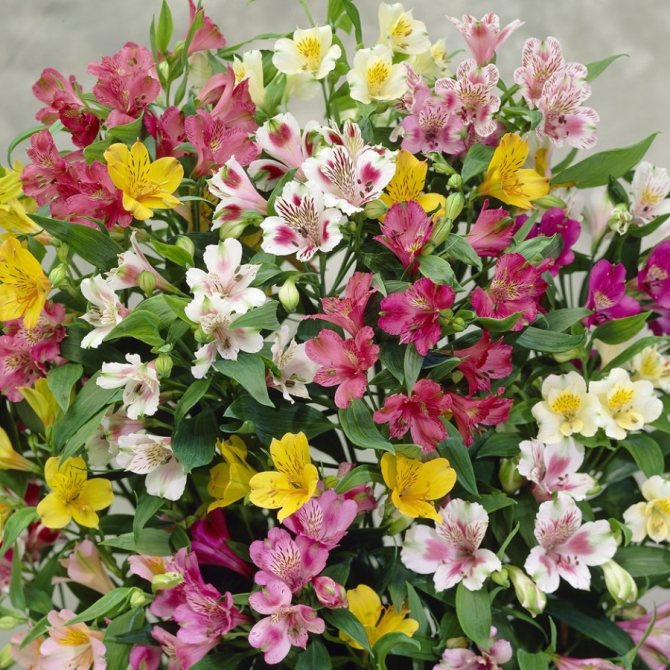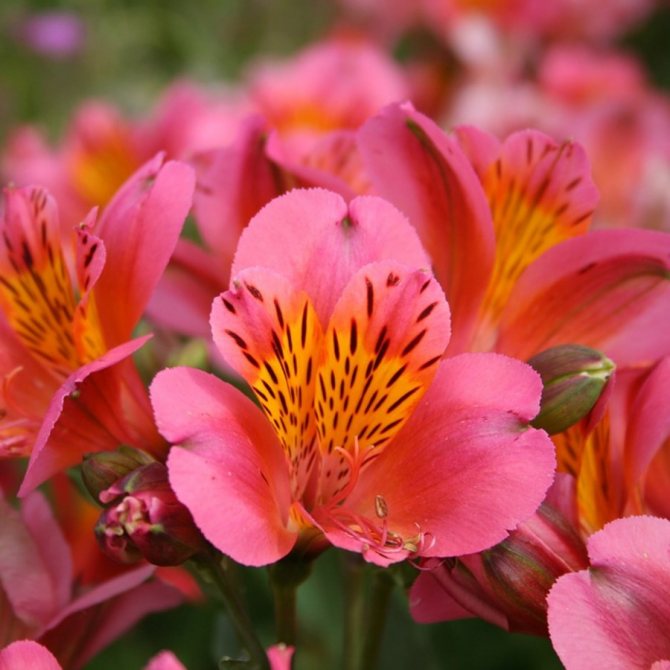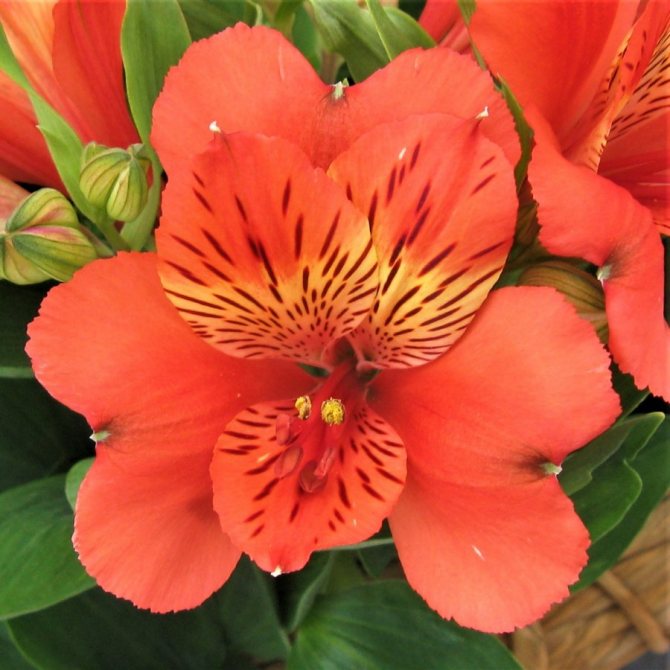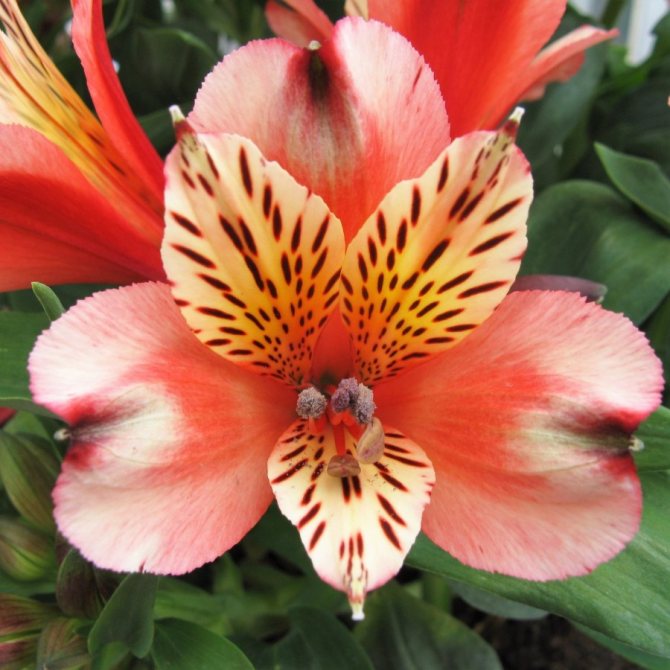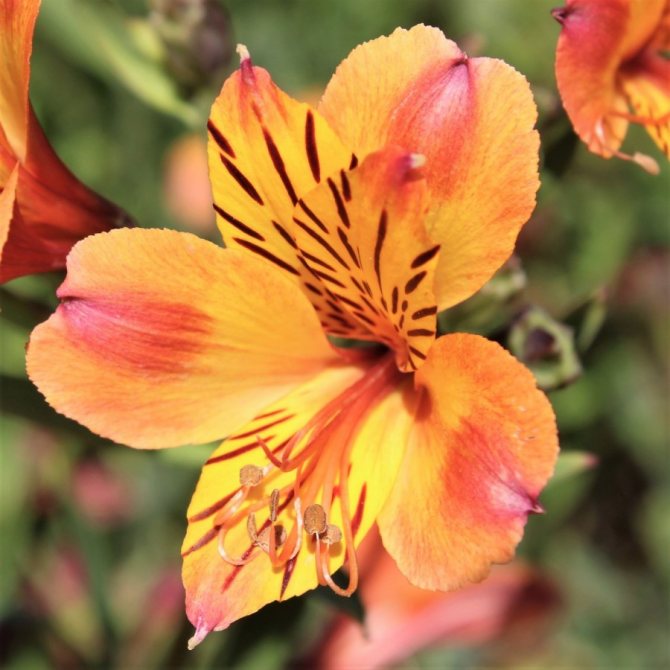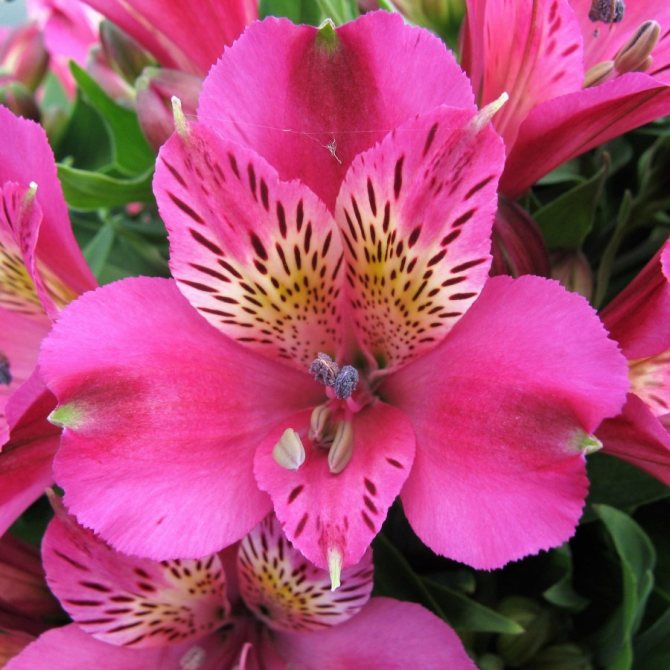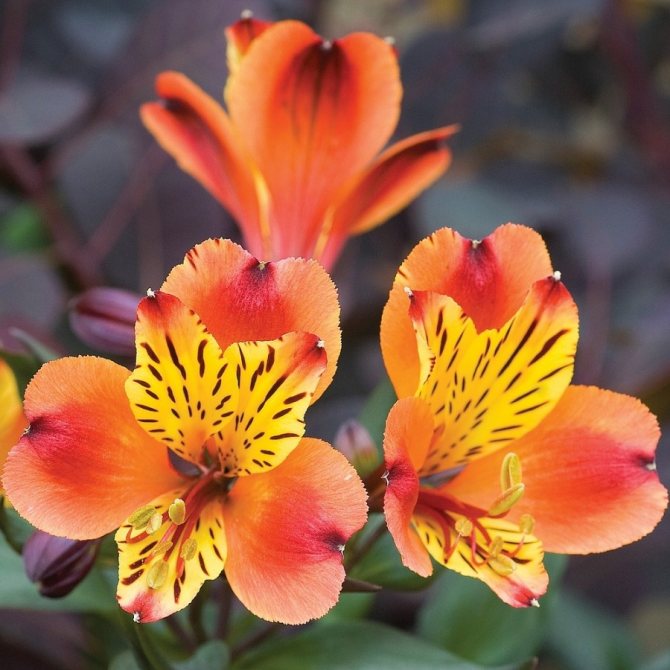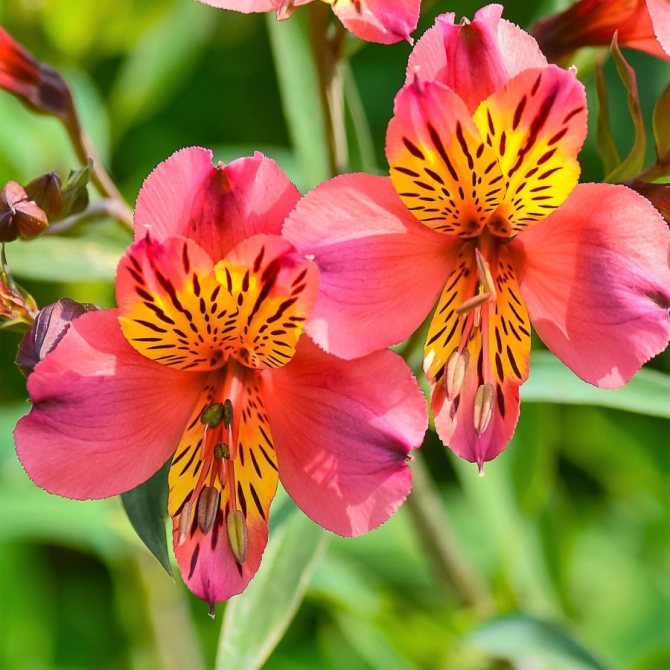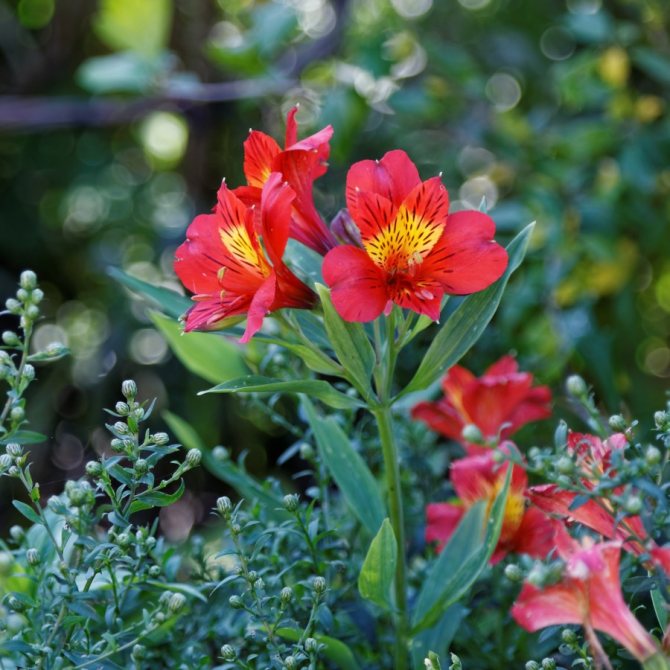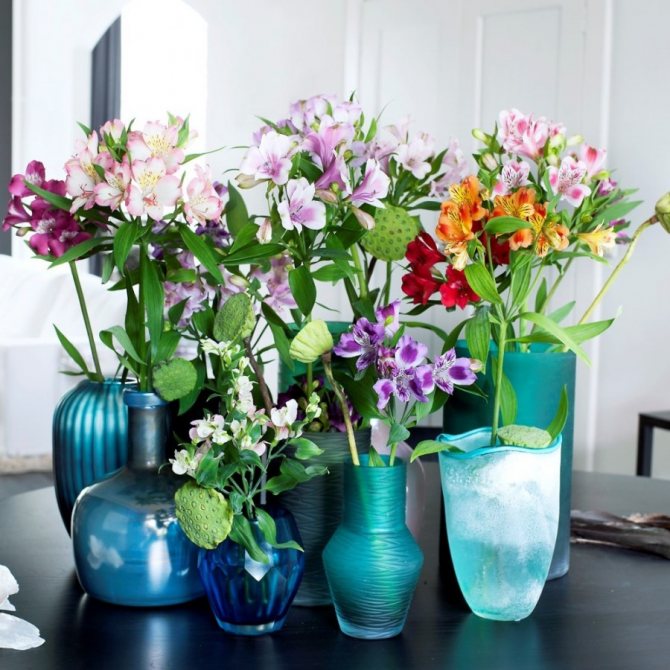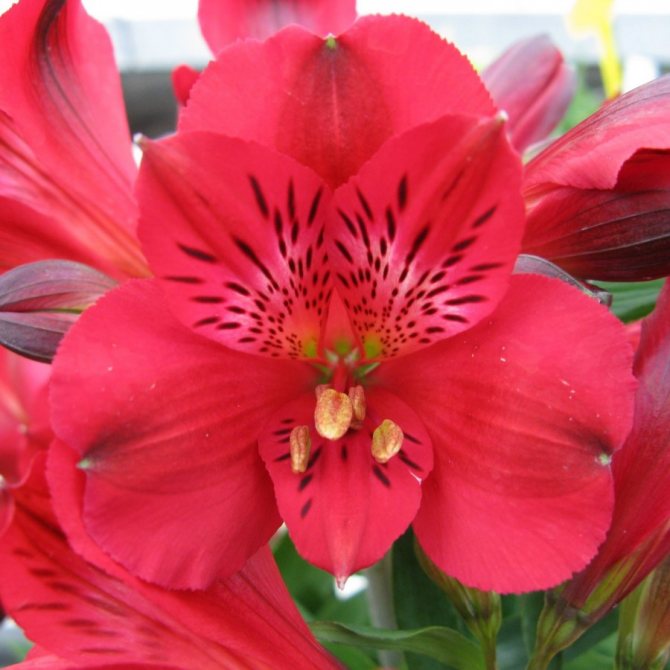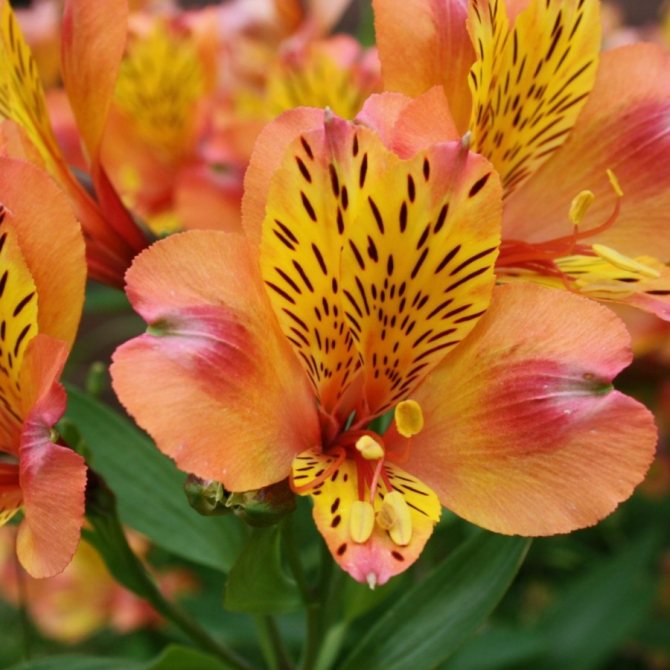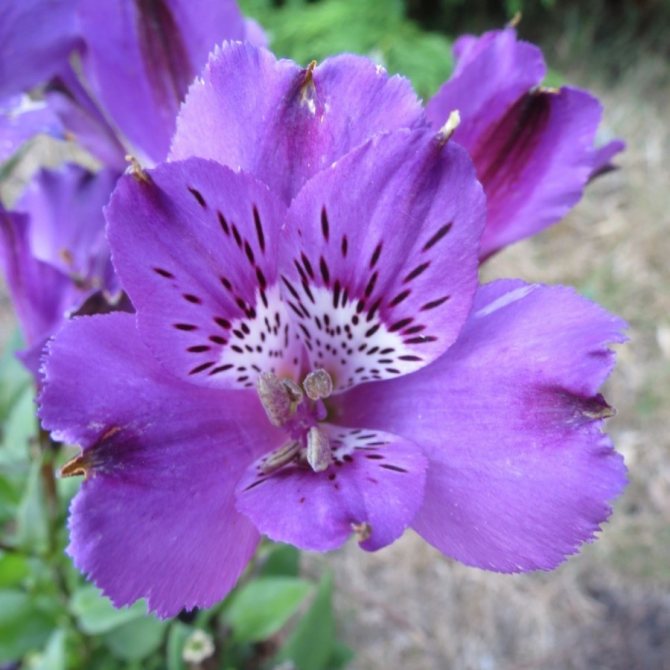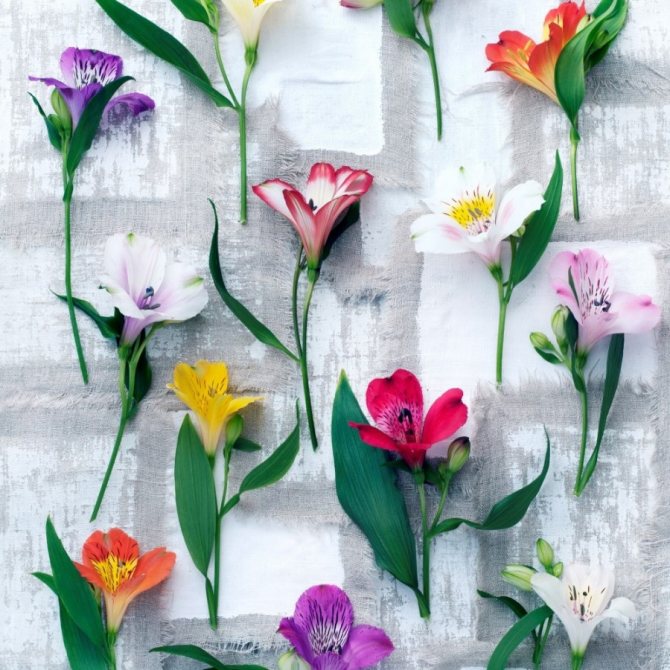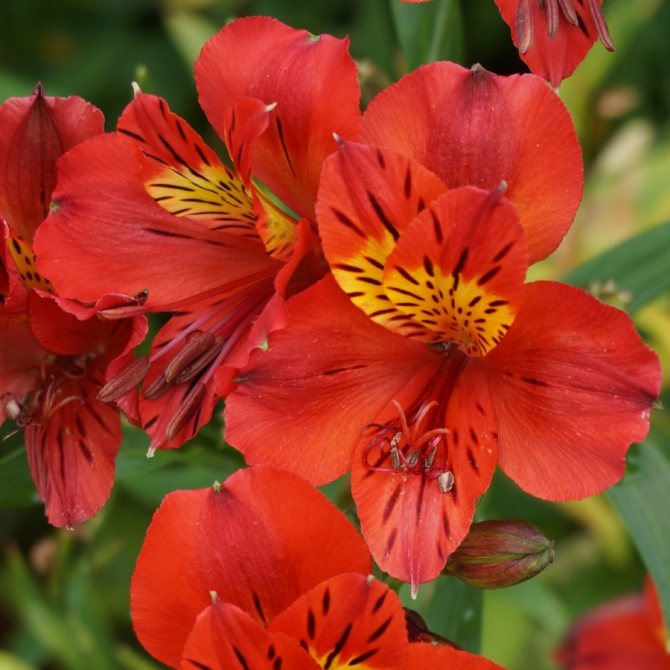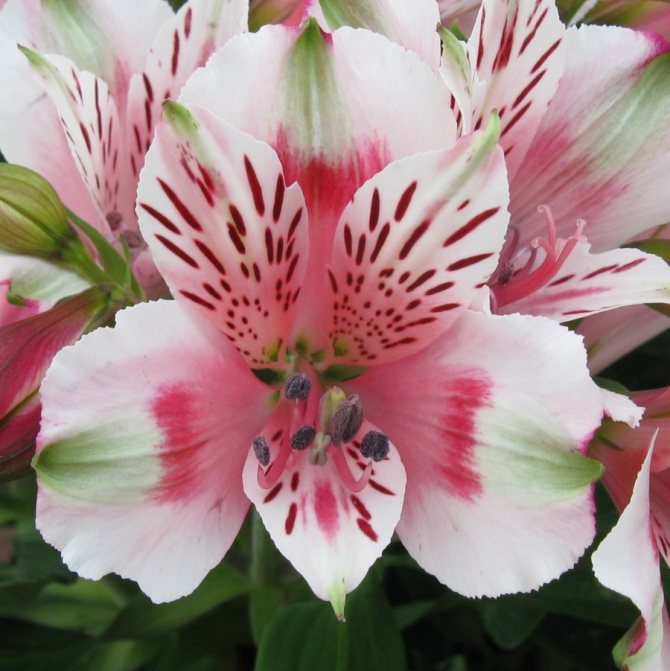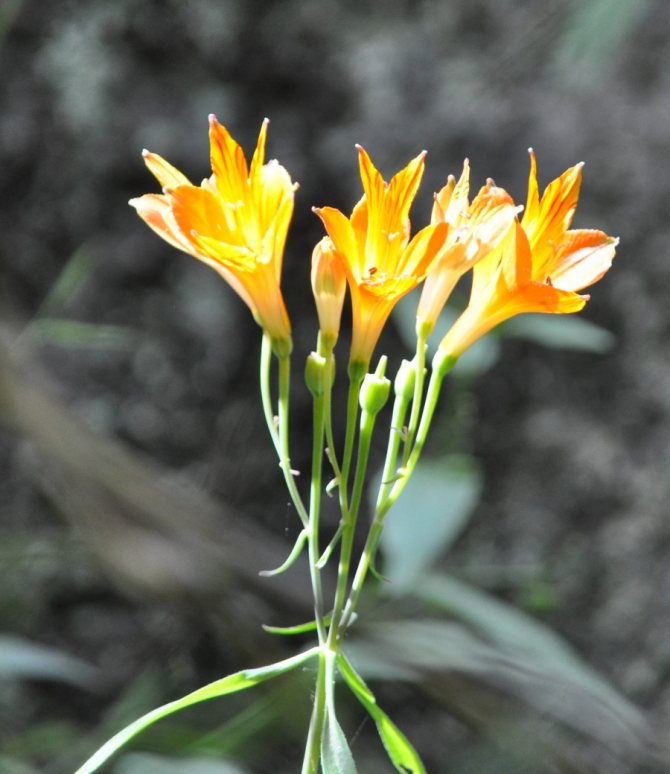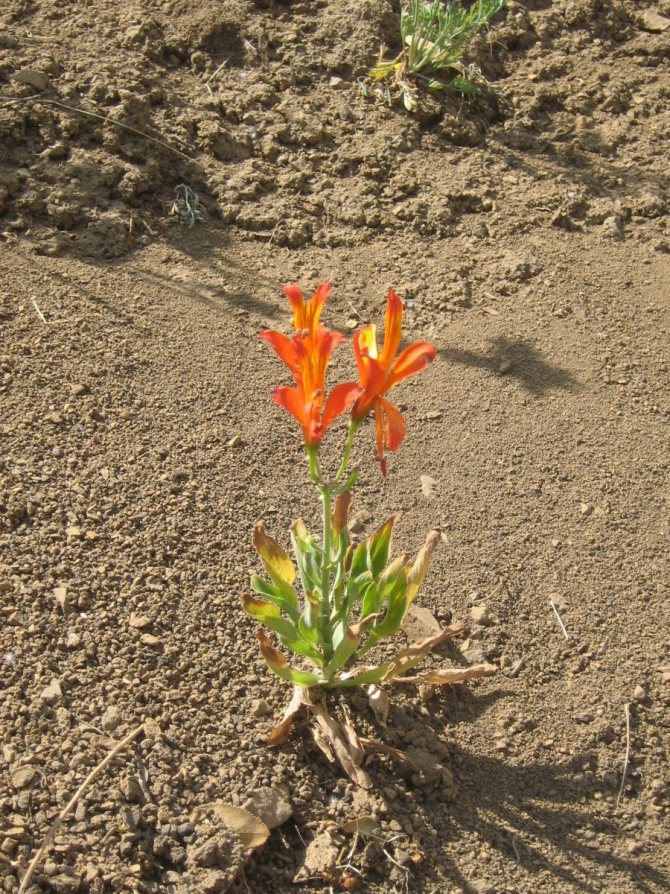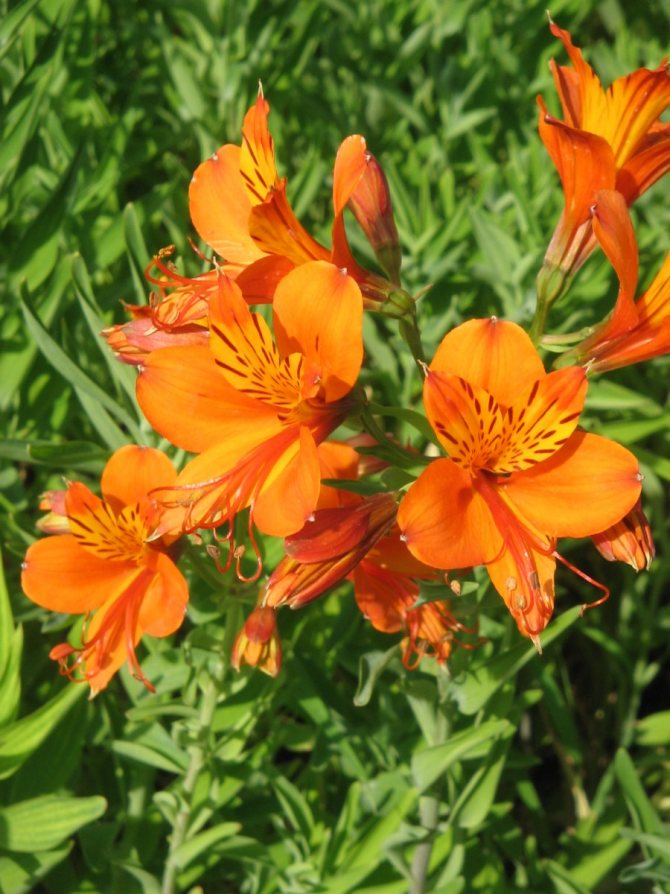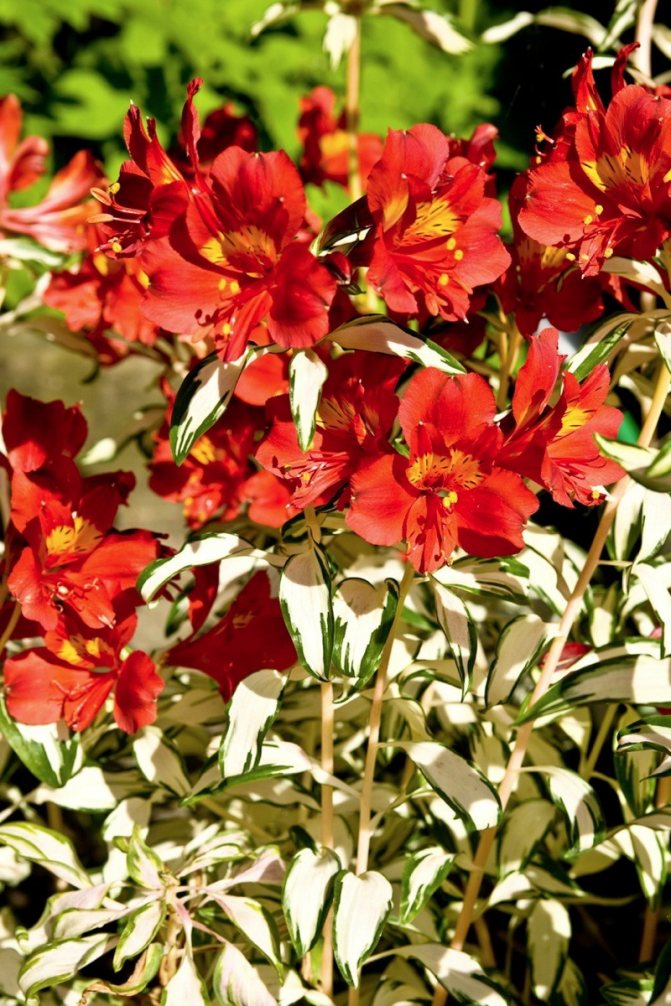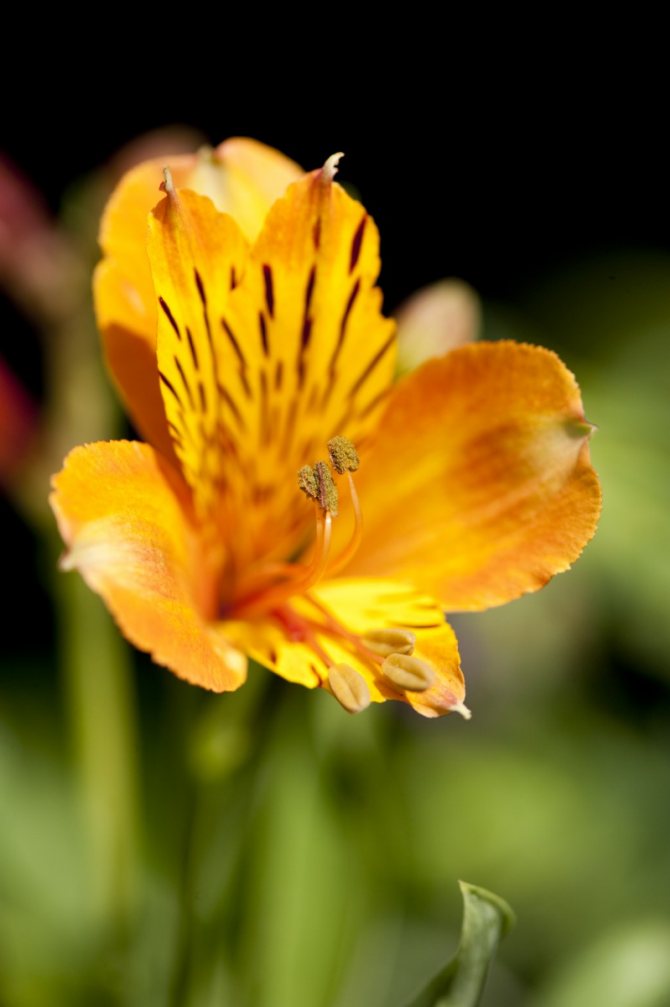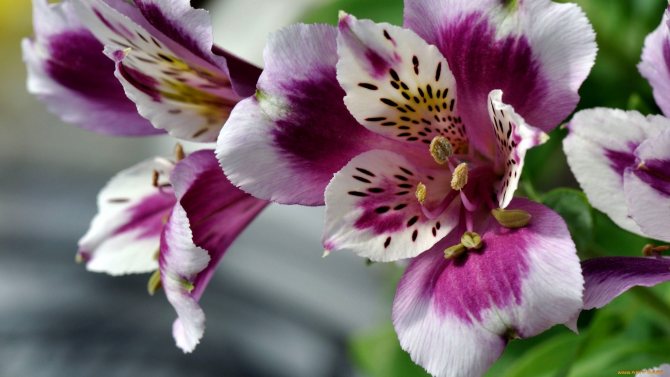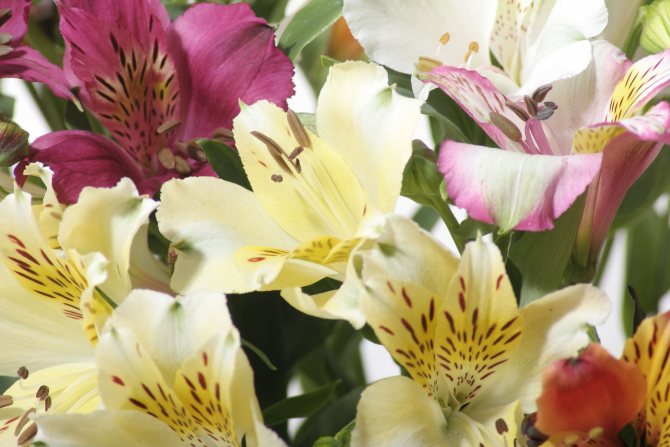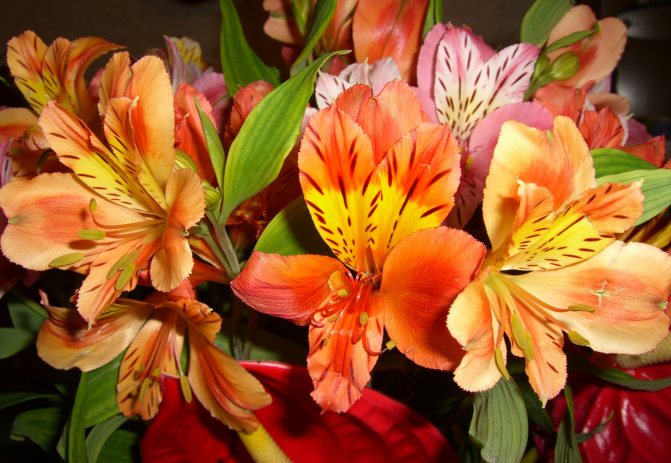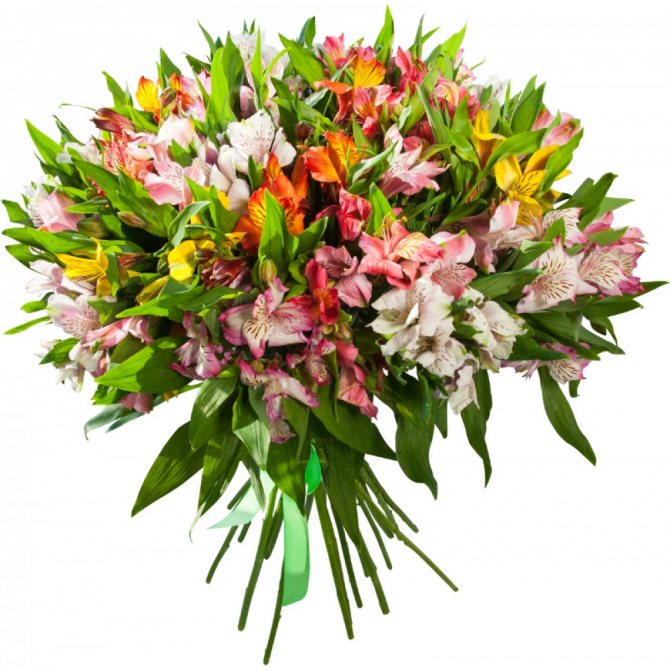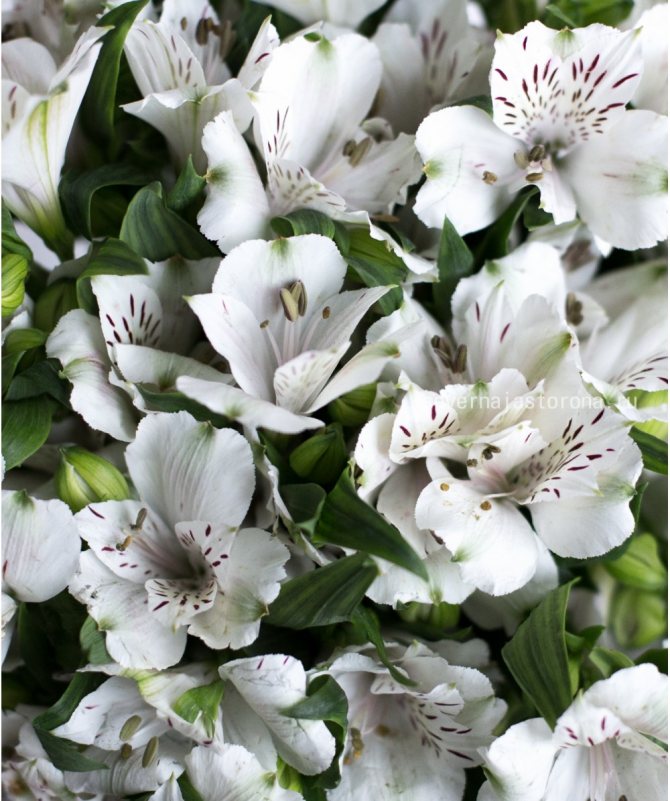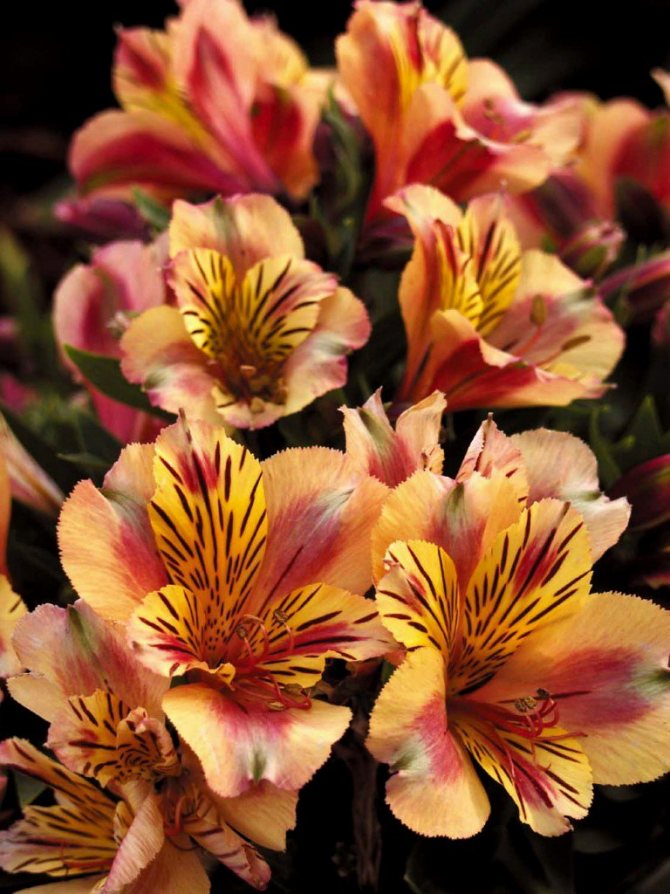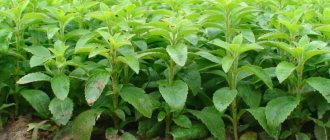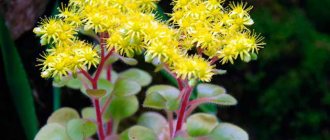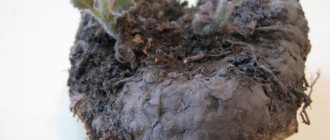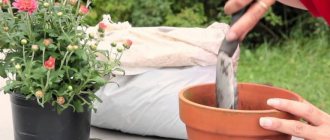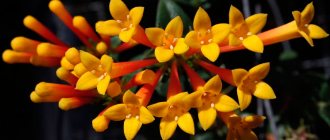The South American rhizome tuberous herb Alstroemeria, also called Alstroemeria, or Alstroemeria, is a member of the Alstroemeria family. This flowering plant is also called "lily of the Incas" or "Peruvian lily". This family and genus was named after a student of Karl Linnaeus - Baron Klas Alström: he was a Swedish philanthropist, industrialist and botanist who lived in the 18th century, it was he who brought the seeds of two types of alstroemeria to his teacher Linnaeus. Very often in the literature, such a plant is called "alstroemeria". In nature, it is found throughout South America. This genus unites approximately 50–100 species. Most of them are widely cultivated as decorative flowering garden plants that can also be used for cutting.
Alstroemeria (Astelmeria) in landscape design
Alstroemeria (Astelmeria) is a perennial plant of the Alstroemeria family, resembling a miniature lily in appearance. A distinctive feature of this type is the twisting of the leaf cutting by 180 degrees. It has a fleshy rhizome that can grow up to 60 cm in length. The flower of the plant has 6 petals with oblong spots of a contrasting shade in relation to the main color. The bud is about 5 centimeters in diameter.
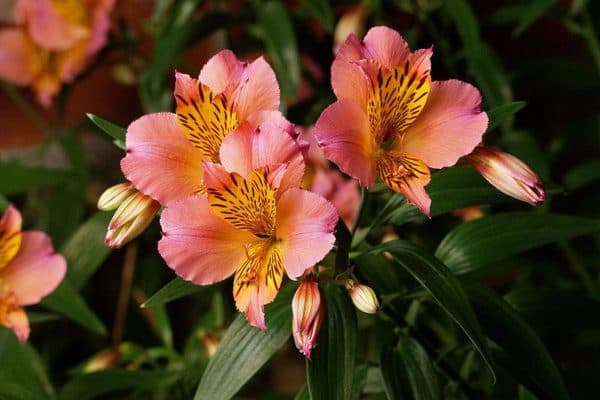
Alstroemeria flowers gather in loose inflorescences like orchids or lilies up to 10-25 buds in one. It blooms 2 times a year.
To date, about 80 species of the wild-growing variant of this plant are known. Such flowers are common in Chile, Brazil, Peru. Shrubs grow well in hot climates with moderate humidity. In horticulture, mainly hybrid species are used, reaching heights of up to 2 meters, growing in greenhouses or outdoors.
Temperature regime
The alstroemeria flower, which is easy to care for, belongs to tropical plants, but loves moderate temperatures. When growing a flower indoors in the summer, it is required to maintain room temperature, while 22 degrees are considered optimal. In winter, it can be lowered to 15 degrees, the minimum permissible temperature is 8 degrees above zero. When growing species varieties, it is possible to choose those that can withstand small frosts. Among the hybrid ones, there are none. However, it is still worth experimenting with the room temperature.
Too high temperatures should also be avoided. For example, if it rises above 28 degrees, the plant risks stalling, quickly shedding its flowers, and then withering. If the temperature rises in winter, this threatens that new buds will not be laid, which means that the plant will not bloom in the new season.
Description of the main varieties
A large number of alstroemeria hybrids are used in landscape design. They can have different bud sizes and petal colors. There are beautiful specimens of pink, white, lilac, orange tones, there are two-color specimens. These varieties differ among themselves not only in color, but also in the flowering time, the size of the buds, the strength of the peduncles.
Description of the most popular hybrids:
- Virginia. One of the largest varieties, the bushes reach a height of 70 cm, the bud itself is large, the petals of the plant are white;
- Alicia. Flower with petals in two colors: white and pink;
- Cosmo. A variety of alstroemeria with large white leaves;
- Granada. Variety with large red flowers;
- Lemon. The flowers of this variety are lemon green in color;
- Orange Queen. The plant of this species reaches 70 cm in height, has large flowers with a bright apricot color.
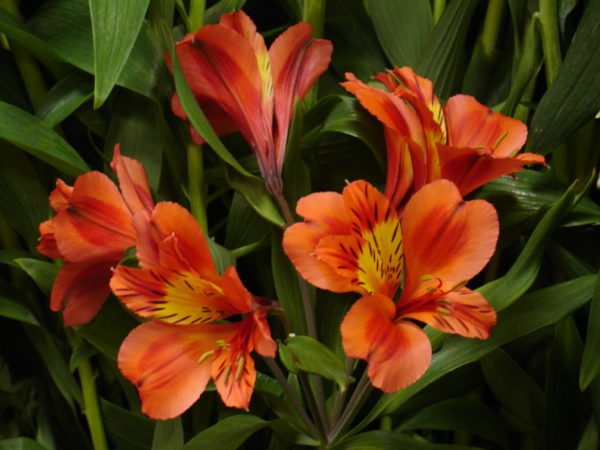

There may be brown spots on the petals.
Productivity of hybrid varieties: 80-100 units. The color of the hybrid and its other characteristics are preserved in the second generation.
Types and varieties
What indoor flowers bring happiness and well-being to the house
At the moment, there are many varieties of alstroemeria. Basically, they are no different, except in colors.
Alstroemeria white
This variety is very often used in making bouquets for the bride. The main characteristics of this species are high growth, resistance to diseases, as well as to sudden changes in temperature.
Alstroemeria pink
As the name suggests, the key feature of alstroemeria pink is its matching hue.
Alstroemeria red
Lovers of red flowers will like this type of alstroemeria.
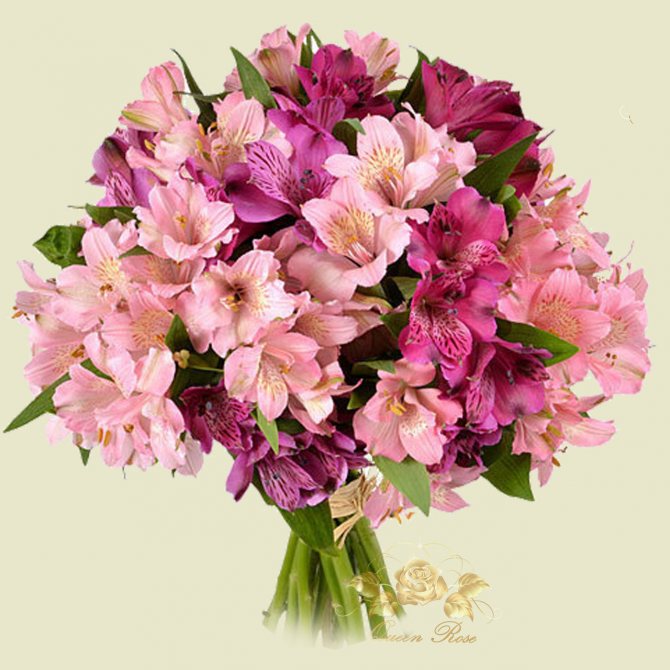

Bouquet of alstroemeria
Its stunning appearance will not leave anyone indifferent.
Alstroemeria purple
A stunning plant with purple flowers that resemble lilacs or violets.
Flower reproduction methods
For planting alstroemeria hybrids on open ground or in a greenhouse, you can use both seeds and fragments of a bush of an annual or biennial plant. The technique of such cultivation will be discussed below.
What varieties of Dahlia exist, you can find out from this article.
What types of Fuchsia can be and exist in detail is indicated in this article.
From seed
Alstroemeria seeds remain viable for 2-3 years. When using this breeding method, the gardener should proceed as follows:
- Sow the seeds on a deciduous-sod mixture prepared in proportions of 2: 1. To obtain flowers in the second year after planting, it is recommended to place the seedlings in a greenhouse in February-May.
- If a decision was made to plant seeds in a greenhouse, they must be placed together with a container in a plastic bag and sent for stratification.
- After 3 weeks, the plants sprout. During this period, it is necessary to remove the film from the seedlings, apply the necessary fertilizers to the soil and make sure that the plants do not succumb to high humidity.
- In May, after the last frost, the seedlings can be planted on the ground. Further caring for them does not differ from caring for seedlings obtained by other methods of flower reproduction.
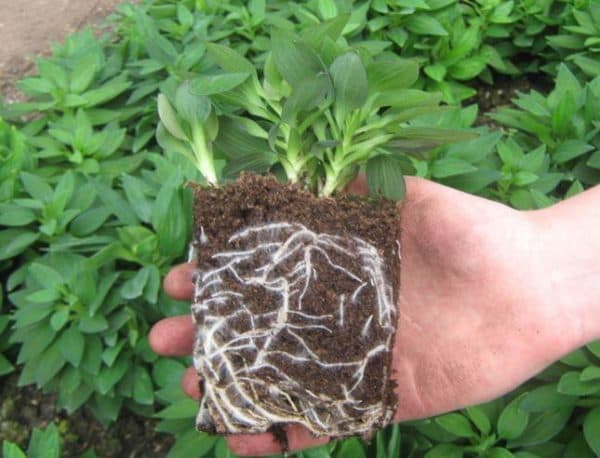

Alstroemeria seedlings, when propagated by seeds, bloom no earlier than in the second year.
You can also sow alstroemeria seeds directly into the soil. This should be done in the warm season, preferably in April after the last frost has passed. With proper care, a plant planted in this way will also develop rapidly, but its flowering will come a year later than shrubs grown in greenhouse conditions. It is difficult for an inexperienced gardener during this period to determine the hybrid of a flower and to predict the further result of the work. Therefore, beginners who want to grow a certain variety of alstroemeria are advised to resort to another method of reproduction - by dividing the bush. This makes it possible to see an adult plant during the flowering period, choose the most suitable sample and already from it get material for further work.
By dividing the bush
Reproduction by dividing rhizomes should be carried out twice a year during periods of semi-rest. Do this in the summer at the end of flowering or in the fall. The procedure for reproduction of alstroemeria by dividing the bush is as follows:
- An adult plant is carefully dug out so as not to damage the bunch. Next, the root is cut into several parts with a knife. Up to 10 cuttings can be obtained from one plant.
- The resulting cuttings are planted, depending on their size, on open ground (large specimens) or in pots (smaller or weaker). Further cultivation of plants is best done in a greenhouse.
- To obtain flowering in the spring, grown plants are planted in September-October on prepared open ground.
In order for the plants to grow correctly, not to get sick and to give flowers on time, it is necessary to correctly approach their planting in the ground. On this issue, there are strict recommendations of gardeners.
Alstroemeria care
Growing alstroemeria is not very difficult: regular watering and feeding will be required. The plant has one feature peculiar only to it: it responds to overheating of the soil above 23 degrees by developing roots to the detriment of flowering.
Advice! Mulching with bark or peat at least 7 cm thick will prevent overheating.
Watering
Alstroemeria requires systematic but moderate soil moisture. The soil should not dry out. In drought they water it more often - twice a week, in rain they manage with natural moisture.
Top dressing
Plants need nutrition on a regular basis. Top dressing is carried out every decade, alternating mineral and organic fertilizers. At the stage of growing the leaf mass, emphasis is placed on nitrogen-containing nutrition. During the period of budding and flowering, alstroemeria's need for phosphorus increases. Potassium should be supplied to plants in the form of wood ash. It is embedded in the soil under the bushes 3-4 times per season.
Transfer
Alstroemeria roots grow rapidly, thickened bushes with many shoots bloom poorly. Every year in spring or autumn, an adult plant is transplanted, combining this procedure with dividing the bush. The rules for planting divided alstroemeria are the same as for planting seedlings. Pits are dug in proportion to the root system.
Advice! In order for alstroemeria to bloom magnificently, the peduncles are cut off without waiting for the petals to fall, and the bushes are thinned out, cutting out weak and deformed shoots.
Planting and growing rules in the open field
Before planting alstroemeria in the ground, it is necessary to properly prepare it on the ground. It should be loose, very nutritious, have high water and air permeability characteristics. If necessary, add 0.6-0.7 grams of ripper per cubic centimeter to it. To do this, you can use compost, bark, sawdust, chaff. Also, the soil must have good drainage, since excess water is detrimental to this type of plant. How the cultivation of Gladioli in the open field is carried out can be understood from this article.
Beds for alstroemeria in open ground should have a width of -1.25 meters and a height of 15-20 cm.The plants themselves are planted at a distance of 40 cm, little-cut hybrids and 50-60 cm - plants with high bushiness. On average, 2-3 units fit in one row.
Plants are planted to a depth of 15 cm in loose soils and 12 cm in deep soils. But what the bulbs of gladioli look like and how to plant them correctly in the ground, you can find out by clicking on this link.


Landings are covered with carnation-type nets with 10X15 lower and 20x25 upper cells at a distance of 20-30 cm. This measure allows alstroemeria to reach up to 2 meters in height in 2-3 years of growth.
How to water properly?
Watering should be plentiful, especially if summer does not pamper with moisture. However, it is necessary to let the soil dry out a little in order to avoid decay of the rhizome. In winter, watering depends on the air temperature: the lower it is, the less water you need to add to the soil. The alstroemeria flower does not tolerate both stagnant water and excessive drying of the soil.
During the growing season, the plant needs a special irrigation regime: the soil must be constantly slightly moistened.
Ideally, the water for irrigation should be soft. To do this, it needs to be defended for about a day.
Home care
This flower is quite simple and unpretentious to care for. In order for it to grow well and please the eye for a long time at home, you must follow the following care recommendations:
- during the growing season, it is necessary to weed the weeds, do top dressing;
- water the plants every 7-10 days;
- during flowering, give the plant a complex feeding;
- monitor the acidity of the soil, avoid lowering it.
Particular attention must be paid to preparing the flower for wintering. With the arrival of autumn, it is necessary to cut off the upper part of the plant and dig up the rhizome. In this case, the soil tuber must be dried and placed for storage in a cellar or basement for the winter, but the plant can be left there only at positive temperatures.
Lighting organization rules
The alstroemeria flower does not belong to shade-loving plants, so it needs a lot of light. However, there are still some peculiarities. In autumn and winter, flower pots can be placed on the southern windows, in spring and summer, you need to ensure the flow of bright, but diffused light. This effect is achieved with a slight shade at noon.
Alstroemeria is a flower that pleases with beauty only if a certain length of daylight is provided. It must be at least 13 hours long. Therefore, if necessary, it is necessary to provide additional artificial lighting, for which only fluorescent lamps are suitable.
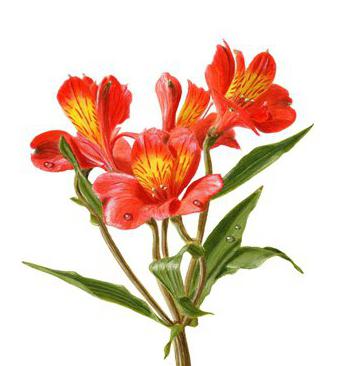

Disease and pest control
Alstroemeria flowers in general are not very susceptible to pests, as well as diseases. Botrytis is considered the main ailment of this plant (popularly - gray rot). This disease appears with insufficient soil drainage, as well as with high humidity (if the plant is planted in a greenhouse) or prolonged rains (if planting was carried out in the open field).
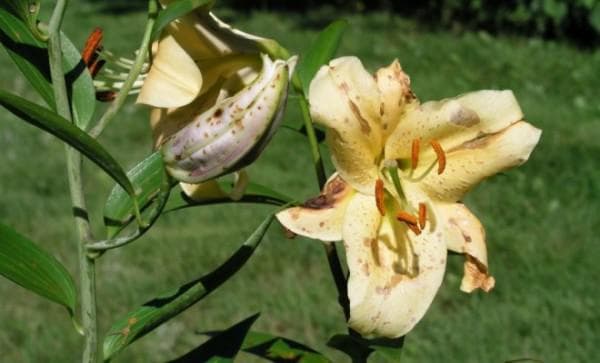

Alstroemeria affected by gray rot
The disease can be prevented. To do this, at high humidity, it is necessary to treat the plant with a fungicide solution 2-3 times a week. For this task, a foundation is best suited. It is used as a 0.1% suspension. With this preparation, it is necessary to spray the plant over its entire height and process its roots. Read also about the Eustoma flower.
If the disease overtook a flower at an early stage of development, it usually cannot be saved and it is necessary to remove the plant from the garden along with the root system. Spraying in this case does not give the desired effect.
Alstroemeria pests are: slugs, gnawing caterpillars, spider mites, beetles and thrips.
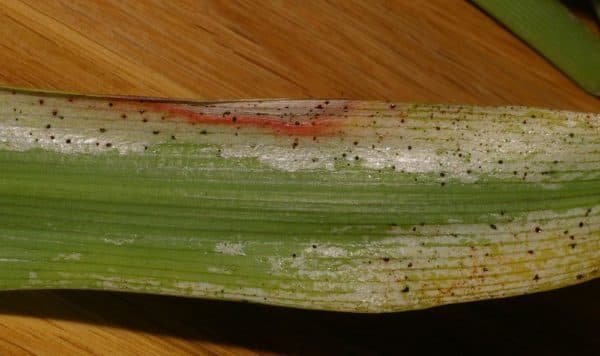

The result of defeat by thrips
The following drugs are effective against them:
- actellik;
- fitoverm;
- aktara.
Important: for pest control on these asthenia, malofos cannot be used, since flowers are very sensitive to it. It is better to choose a softer mixture for this purpose.
An effective agent in the fight against pests is 0.05% or 0.1% actellic solution. It effectively removes aphids and other parasites and does not damage plants. It is necessary to spray flowers with this tool when the first signs of damage to the plant appear. Damaged buds and leaves should be cut off.
Transplant rules
This process needs to be carried out every year, but better in the spring. This is due to the fact that the root system of alstroemeria is quite powerful, which means that it consumes a large amount of minerals from the soil and develops rapidly.
The following soil composition is suitable for transplanting:
- sheet land (2 parts);
- peat (1 part);
- humus (part 1);
- perlite (1 part);
- pine bark (1 part).
In addition, it is necessary to check the acidity level of the prepared soil. The pH should be 5 or 5.5, that is, the alstroemeria flower, the care of which requires attention, loves slightly acidic or acidic soil.
If you decide to purchase ready-made soil from a flower shop, formulations for azaleas and rhododendrons are ideal. And don't forget about drainage.


Planting a plant for seedlings
You can plant flower seeds immediately in open ground, this process is best started in late April or early May. The first shoots should appear in twenty days. However, experienced flower growers strongly recommend planting seeds for seedlings and starting to do this at the end of February.
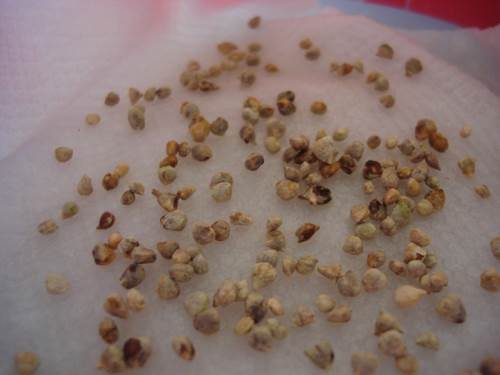

Seeds before planting
Before planting seeds for seedlings, it is imperative to do a special stratification procedure. To do this, the seeds are carefully placed in a damp cloth and placed on a shelf in the refrigerator for vegetables, here they must lie for 28 days.
After that, you can start planting seeds in a specially prepared soil, while deepening the seeds only need ten millimeters. Then the planted seeds are covered with a film or glass and the temperature in the room is set to 18 C. You should not water the seeds. If you do not want to engage in further diving of seedlings, then it is advisable to immediately plant the seeds in separate peat cups, in addition, flowers in open ground can be planted directly in them.
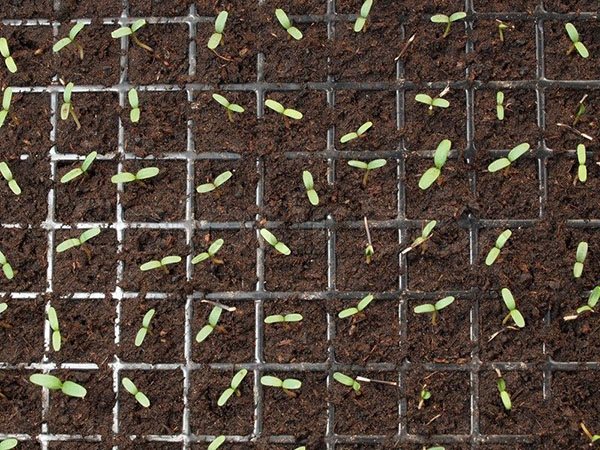

Alstroemeria shoots
The first shoots usually appear twenty days after planting. Alstroemeria seedlings are looked after in the same way as other seedlings of garden flowers, they must be watered, at least two times should be fertilized before planting in open ground, namely, during the appearance of the first full-fledged leaf, feeding with a weak mullein solution will not interfere. The second top dressing consists of three grams of nitrate, six grams of superphosphate and three grams of potassium sulfate, mixing it all with two liters of water.


Top dressing of seedlings
If you planted the seeds in one large container, then after the third leaf appears at the shoot, you need to pick into separate cups. Top dressing is carried out no earlier than five days after this procedure. In order for future flowers to feel comfortable in the open field, you need to start hardening 15 days before planting in the ground, bringing the seedlings to fresh air. Do not forget to increase the time the flowers stay on the street each time.
Life extension of a bouquet of alstroemeria
After cutting, alstroemeria flowers retain their attractiveness for at least two weeks, but for this it is necessary to properly care for and carefully maintain a bouquet of alstroemeria.
Flowers are cut when the buds are just beginning to open, the leaves are mostly removed. They are kept at a temperature of + 5 ... + 7 ° C, for example, next to an air conditioner. The water is replaced daily with clean, settled water (citric acid, vinegar or ammonia are added), the vase is disinfected. Fading buds are constantly removed. Can be fed with flower additives (Bud, Vitant).
Care during growth
The ideal temperature for the growth of alstroemeria is + 20 ° C. In hotter weather, the flower also feels good, but it does not bloom. To protect the plant from overheating in the heat, the soil around it is mulched. You can use a layer of sawdust or peat with organic compost, 8 cm thick.
Water regularly, but in moderation. The water should not be cold. Keep the ground moist, but avoid liquid stagnation. Otherwise, the roots will begin to rot.


When planting, add organic fertilizing: "Humisol", bird droppings, mullein. Before each flowering, feed with mineral fertilizers.
Regularly remove weeds and loosen the soil, cut off inflorescences that have faded and dry leaves.
Pests and diseases
Pests:
- spider mite;
- slugs;
- thrips.
Diseases to which alstroemeria is susceptible:
- root rot;
- fusarium;
- late blight;
- gray rot.
Botanical description of Alstroemeria
Alstroemeria (Alstroemeria) is a rhizome tuberous herb from the Alstroemeri family. The roots of the plant are fusiform, succulent. Shoots - erect, rather flexible. In their upper part, solid, thin, slightly curved leaves of a linear shape are alternately placed.
Alstroemeria has one feature - resupation - this is when the leaf petioles are twisted by 180 °, as a result of which the upper part of the leaf blades is below, and the lower, on the contrary, is on top.
Alstroemeria flowers consist of 6 petals, lanceolate or lobed, arranged in two circles. The color and shape of the petals depends on the type of plant. The color of the flowers can be yellow, orange, pink, red or lilac, spots can be located on their surface.
The upper part of the petals is covered with longitudinal streaks of dark color, which become thinner and shorter closer to the middle. In addition to the petals, there are also six stamens in two circles, and the nectarics are located at the base of the petals of the inner circle.
Alstroemeria blooms in spring and summer, but under favorable conditions and proper care, it can bloom again in September. After pollination, a capsule fruit is formed, where large round seeds ripen.
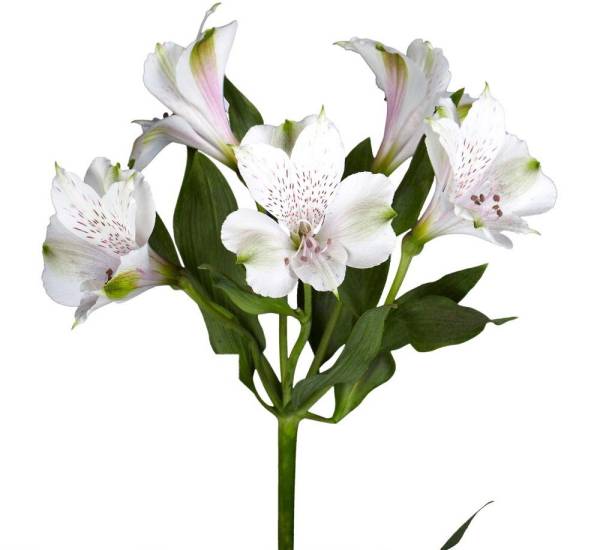

Alstroemeria white
Outcome
Alstroemeria bouquets are good because they stand in water for more than two weeks, are not allergenic, have practically no smell. Numerous varieties differ in a variety of magnificent shapes and colors. Spectacular hybrid species do not require complex cultivation, they bloom stably in open flower beds throughout the summer season until autumn frosts.
Now read:
- The main technologies for growing peas and caring for them
- Three methods of reproduction and transplanting the dollar tree
- Zircon for plant growth based on natural ingredients
- Confidentiality
About
Leading Researcher of the Laboratory of Vegetable and Berry Crops, Yakutsk Research Institute of Agriculture, Siberian Branch of the Russian Academy of Agricultural Sciences, Republic of Sakha (Yakutia).
Reproduction by dividing the root
Root division is suitable for both main varieties and hybrids, because, in this case, the plants will retain all the maternal properties. Dig alstroemeria in the fall, when it fades, or in the spring, in April. The roots of alstroemeria are very fragile, therefore, having dug out, they must be carefully lifted and, having divided, immediately planted back into the ground. The root is divided into 2-3 parts because each of them must have a sufficiently developed and viable root system, otherwise the plant will not be able to bloom for a long time.
Alstroemeria - popular plant species
The most popular types of alstroemeria are:
- Alstroemeria nano (Alstroemeria nano)
- the smallest species, from Patagonia; petals are yellow-orange with black specks and a thin white stripe along the edges; height - no more than 10 cm; - Alstroemeria Alisia (Pink Alstroemeria Alicia)
- pale pink petals with dark brown specks;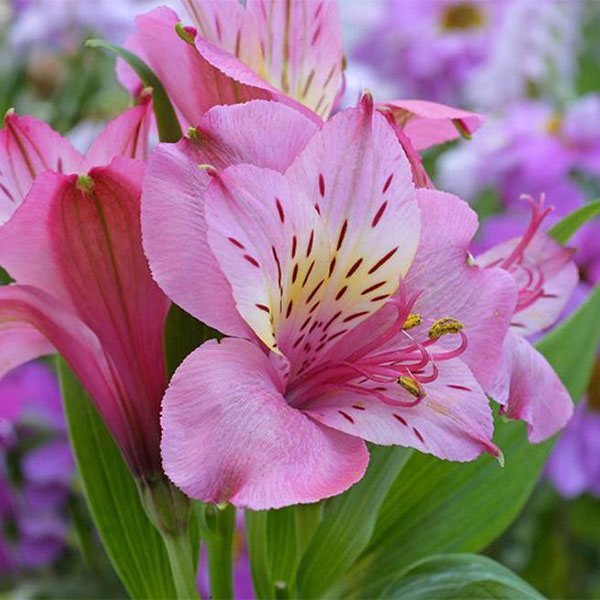

- Alstroemeria aurea (Alstroemeria golden)
- lemon-colored petals with burgundy specks; stem height - up to 0.5 m; continues to develop at minus temperatures;
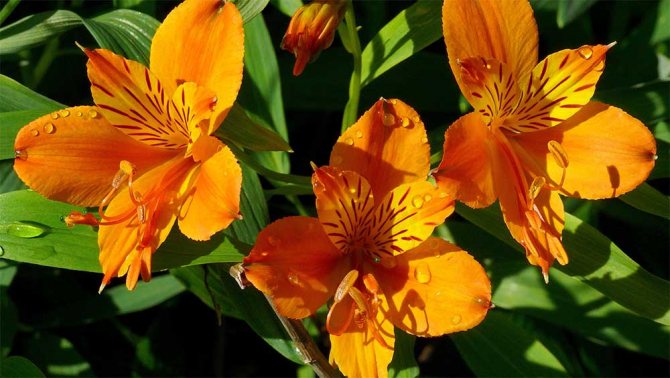

- Alstroemeria lemon (Lemon)
- large flowers of bright lemon color, dark specks and pistachio edging;
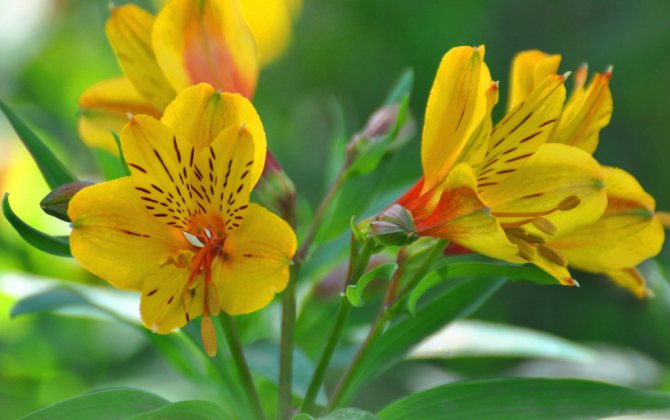

- Alstroemeria haemantha
- 10 - 15 purple flowers with yellow specks are formed on peduncles; grows in a lush bush; - Alstroemeria psittacina
- carmine petals with dark specks and a thin green stripe along the edges; this species is often called the Peruvian lily, the parrot flower or the princess of the lilies; in nature, it is found in Argentina, Brazil, New Zealand (there it was nicknamed the Christmas bell, because the flowering coincides with the holidays). - Alstroemeria Virginia (Virginia)
- the white flowers of this variety of alstroemeria look just great.
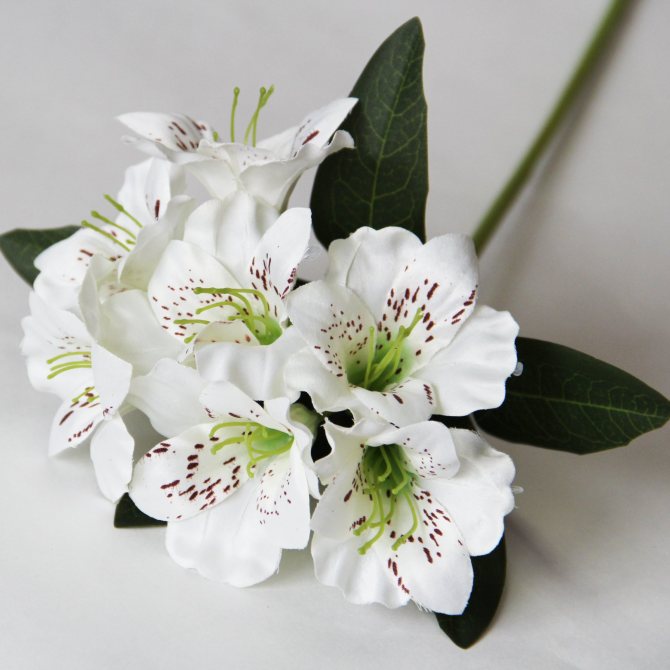

The starch, obtained from the roots of certain plant species, is used as a thickening agent in traditional medicine in South America. Alstroemeria is not used in Russian medicine; It is believed that all parts of the flower contain poison, so it is not recommended to grow it in homes where there are animals and small children.
Preparation stages before planting alstroemeria
Alstroemeria is an exotic plant, therefore it requires serious attitude and attention. It is important to prepare thoroughly before boarding. To do this, you need to choose healthy alstroemeria seedlings, choose a suitable place on the site, or find an ideal indoor pot for this plant. It is also important to properly prepare the soil.
Stage 1. Selection of varieties and seedlings of alstroemeria
- Alstroemeria is a thermophilic plant that needs a warm climate with mild winters. However, there are varieties that can withstand light frosts with cover.
- Currently, breeders have bred varieties for the middle lane.
- It is best to buy alstroemeria in specialized stores or agricultural firms that are professionally engaged in plant breeding.
- When buying alstroemeria planting material, choose only varieties adapted to the climatic conditions of your region. You can ask a consultant about the peculiarities of growing certain varieties.
- You can purchase alstroemeria seedlings or seedlings.
- Inspect the seedling carefully before purchasing. It should be free of visible damage, as well as signs of diseases and pests.
- Different varieties of alstroemeria have different heights, so before buying, decide on the planned garden composition. Shorter varieties are great for growing in containers or indoor pots.


Stage 2. Choosing a landing site
- Alstroemeria can be grown in greenhouses or greenhouses, as well as in indoor pots. More frost-resistant varieties can be grown outdoors in central Russia and the CIS countries.
- Low-growing varieties, such as nano alstroemeria, are excellent for growing in containers that can be placed around the site, and brought into a loggia or greenhouse for the winter.
- Tall varieties are suitable for growing in flower beds and flower beds.
- Warm and sunny places are great for planting alstroemeria. However, the sun should not get too hot. For full growth, it is better to create a light partial shade.
- The selected area must be protected from strong winds and drafts.
Stage 3. Selection and preparation of soil
- A slightly acidic or neutral soil is suitable for the growth of alstroemeria.
- The soil should be light and nutritious. Sandy or clayey soils are suitable.
- The planting site must be dry and well-drained.
- If the soil in your area is heavy, then alstroemeria will grow poorly. In this case, add peat, rotted manure before planting.
- Dig up the selected area thoroughly one day before planting the plant, loosen the soil and add compost.
Possible problems
Most often, alstroemeria flowers, photos of which are presented in the article, are susceptible to attack by thrips, and if the plant is kept in conditions of elevated temperature, then ticks.
Thrips tend to take refuge in buds and flowers, hiding under the petals. Since the color of alstroemeria is variegated, it is almost impossible to detect these pests. Leaves help in the diagnosis. On them you can see punctures, spots and strokes, which are brightly highlighted. Systemic insecticides, for example, aktara, will help get rid of these pests.
If we talk about diseases, then most often the alstroemeria flower becomes infected with root rot, late blight and fusarium. The main reason is excess moisture in the soil.
Growing alstroemeria: choosing a place and leaving
Alstroemeria prefers slightly acidic or neutral soil with good air and water permeability. The plant grows and blooms better where sand is present in the soil or a good drainage system is created. The looseness and lightness of the soil is the key to excellent flowering, so you need to take care of this at the stage of choosing a place for alstroemeria.
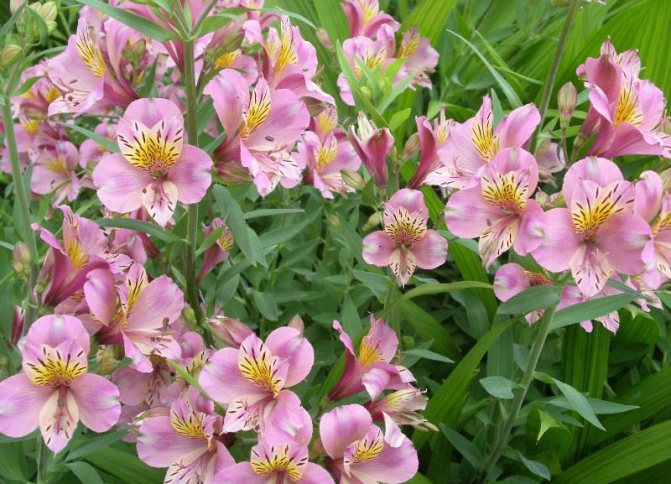

It is recommended to plant alstroemeria according to the scheme 40 x 60 or 40 x 20 cm, depending on the size and growth of the bushes. After planting, water it moderately and regularly, preventing the soil from drying out even on the surface. More attention should be paid to loosening and weeding. To avoid wasting time, it is better to use mulch - it will drown out the weeds and create a layer due to which the soil surface will remain loose.
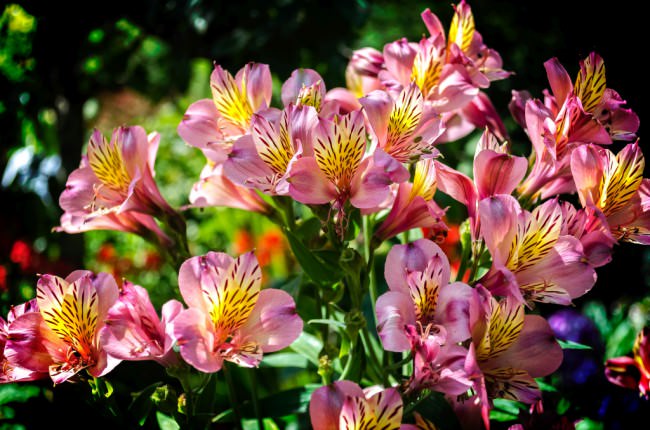

During the flowering period, wilted parts of alstroemeria must be removed, and in autumn the entire ground part must be cut off at a height of 5-7 cm above the soil level. At this time, it is useful to mulch the beds with alstroemeria with humus or compost, and cover them on top with straw or spruce branches. It is recommended to do this after the onset of cold weather, so that the plants do not spill out under the rays of the sun.
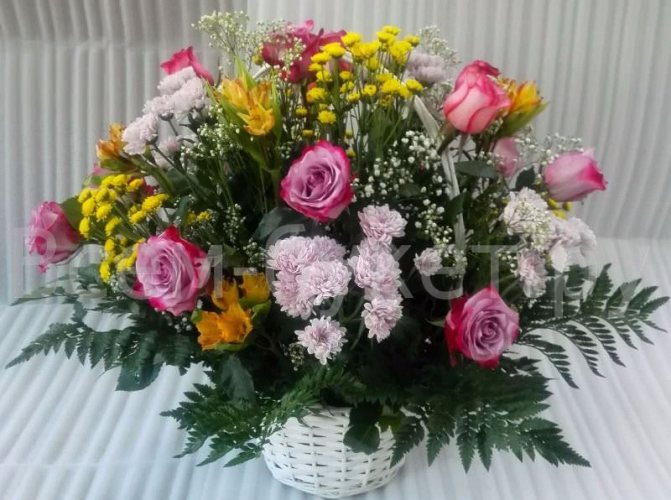

At the risk of freezing, the roots of alstroemeria can be placed together with a lump of earth in a cellar with a winter temperature of about 0 degrees.
Alstroemeria flower photo
Photo gallery
A little about the history of the plant
In ancient times, the Incas called alstroemeria the great gift of the sun god. With the help of this magical offering, one could become invisible or miraculously transform into animals. Outwardly, the flower looks a little like a lily. Sometimes in flower shops they write on the labels: "Alstroemeria is a hybrid of an orchid and a lily", but this is a delusion, although for a long time the flower was called the Inca lily (and in some sources - the Peruvian lily).
Officially, the flower was called alstroemeria when it was recognized in European countries. The plant is named in memory of a student of the outstanding biologist K. Linnaeus - Claes Alstroemer, who presented the teacher with the seeds of two species of an unfamiliar flower brought by him from distant Spain.
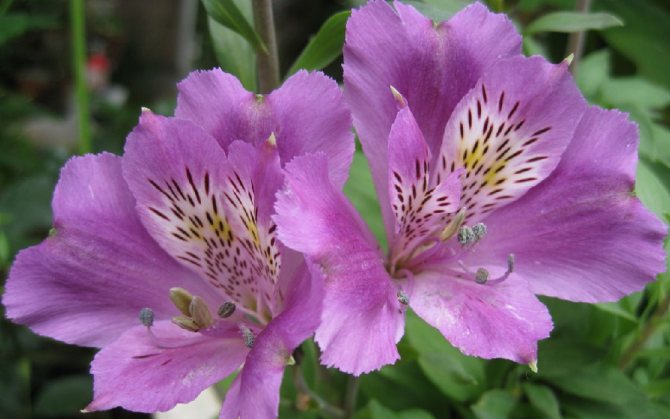

Preparing for winter
After the flowering period has passed, and this lasts about 60 days, all flowers will wither, the resulting arrows should be cut off. You can even leave them at the level of the soil surface. The rest of all the stems must be shortened by 20 centimeters. If we are talking about an adult plant, the remaining shoots are covered with spruce branches, foliage or spruce branches, and from above all this is covered with a film and covered with soil or humus. Thus, by insulating the plant, you will protect it from severe frosts.

